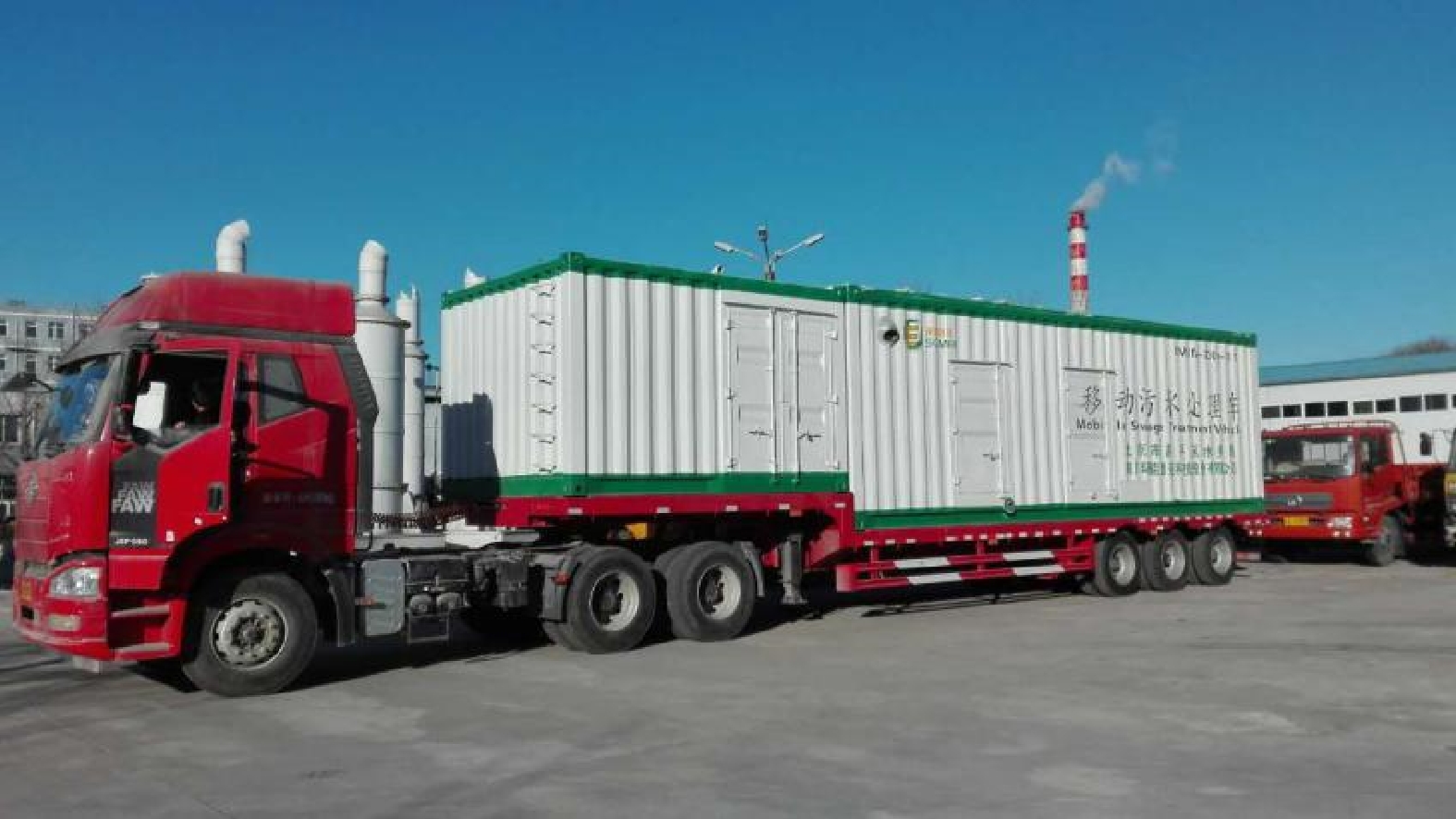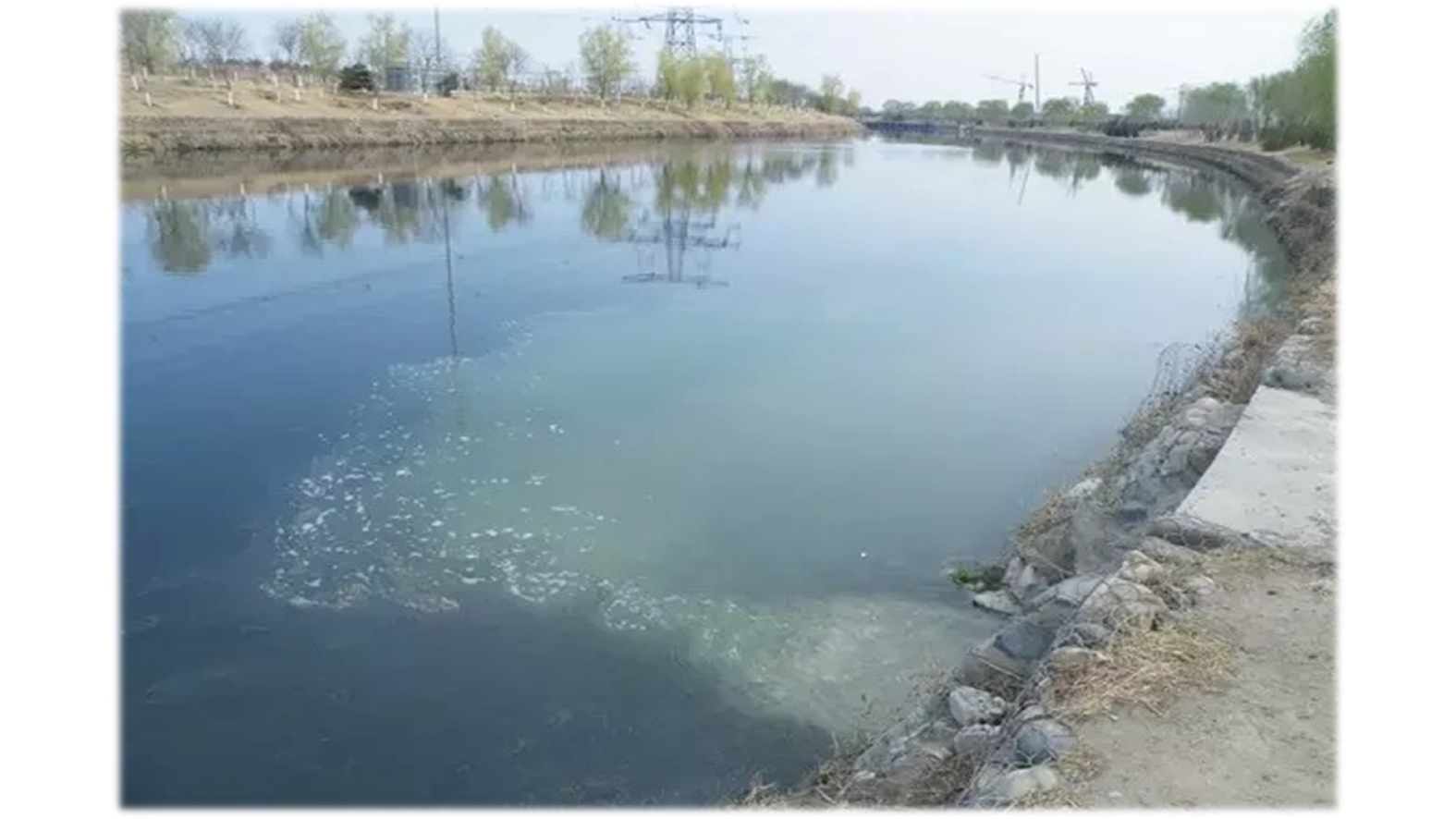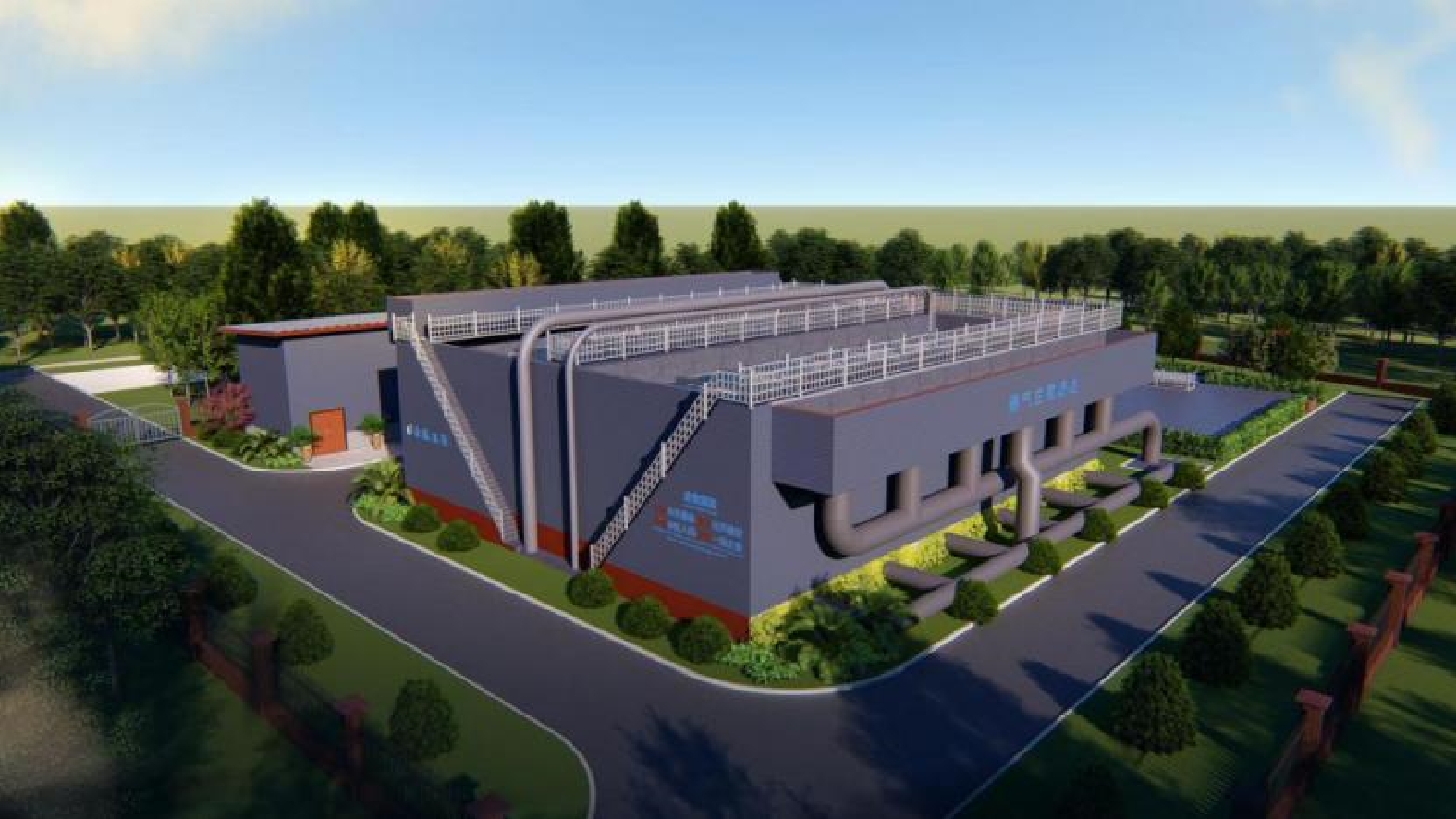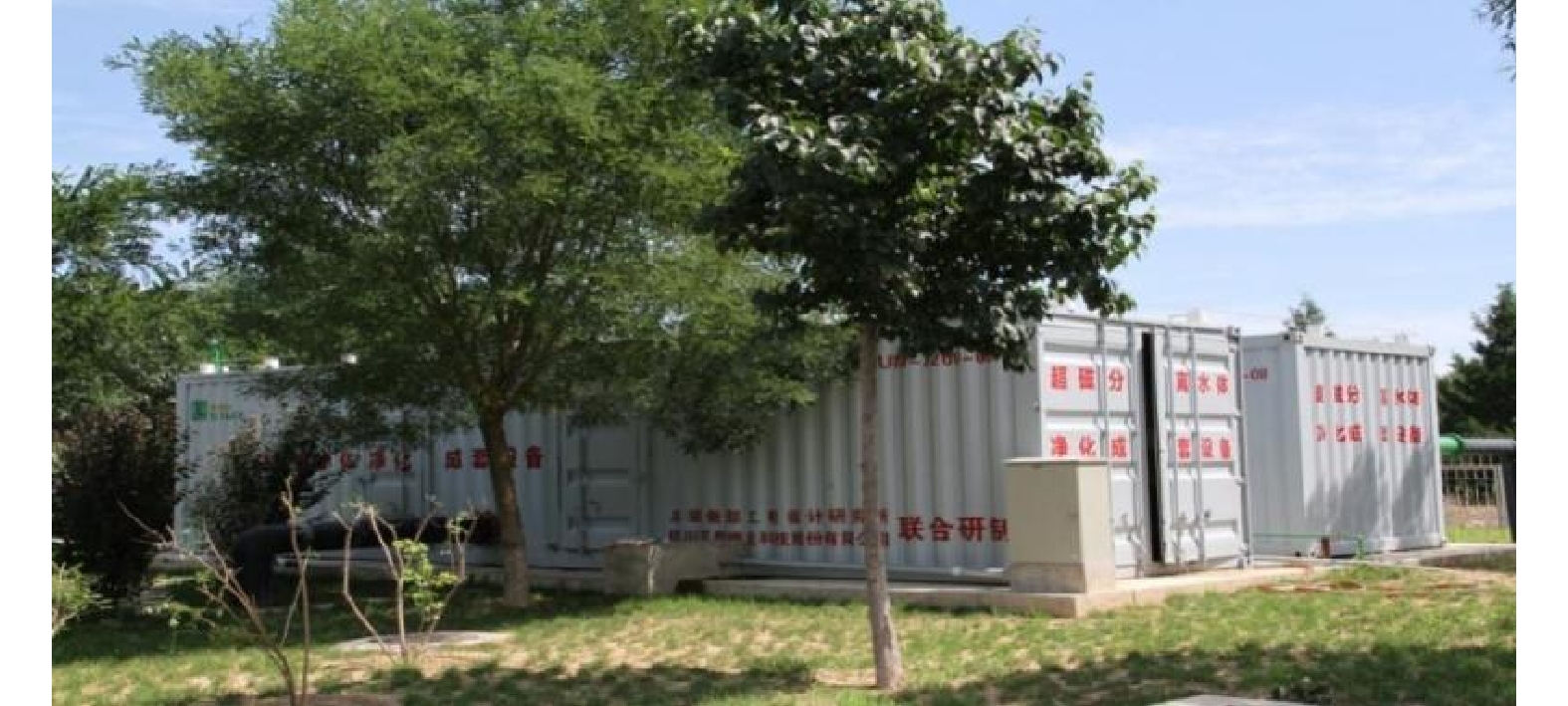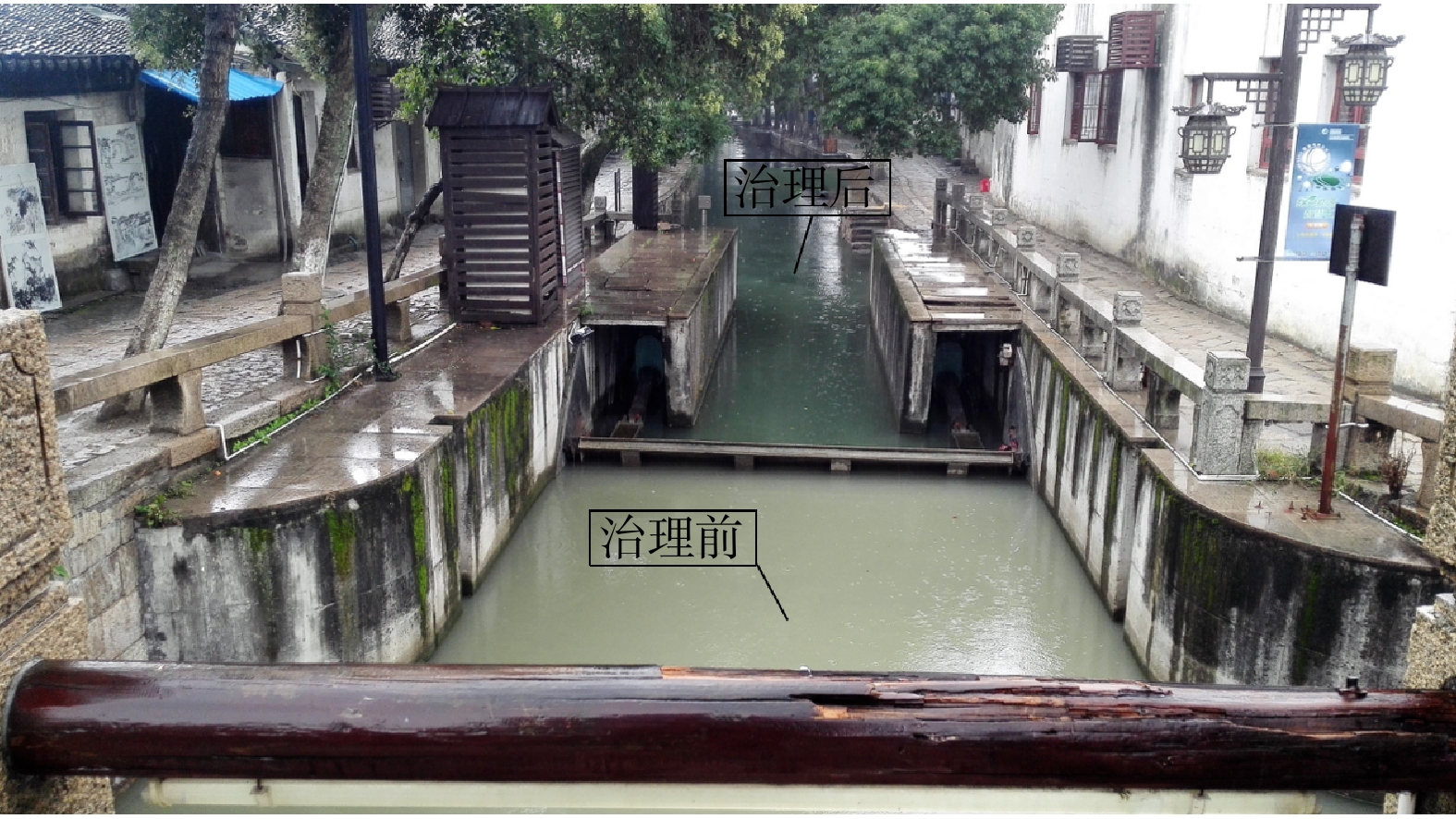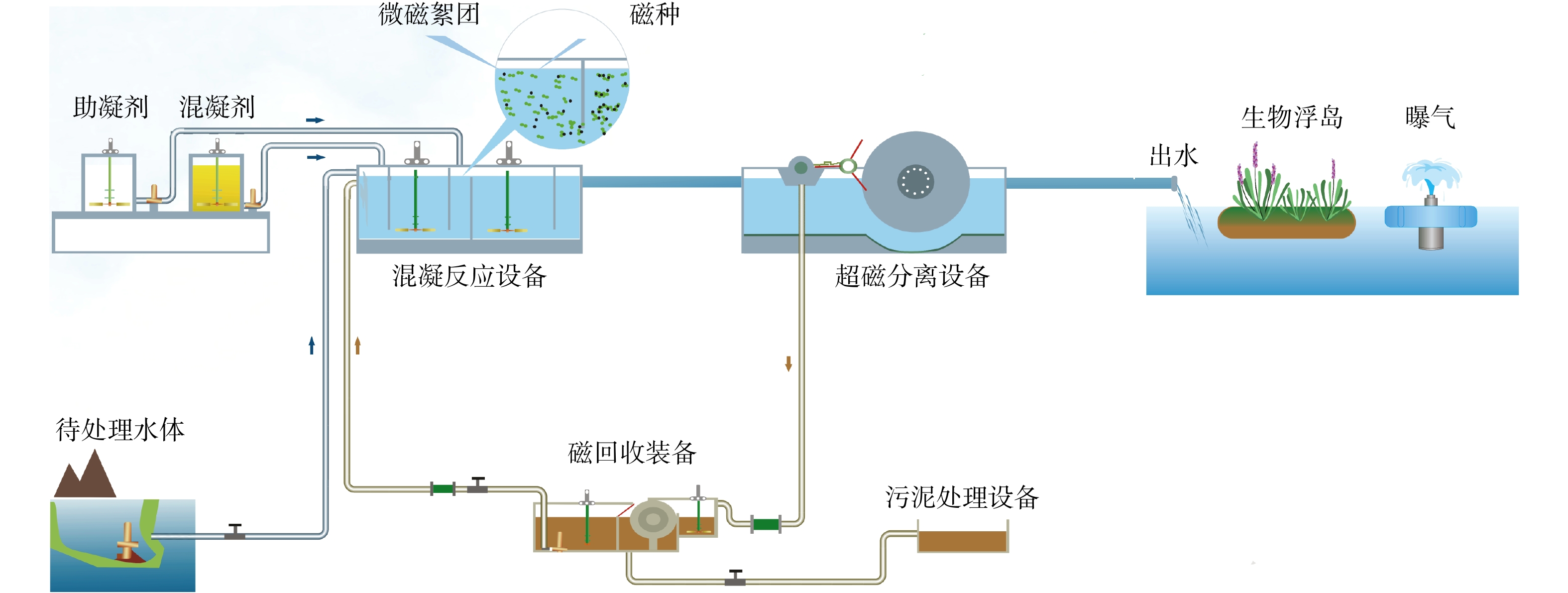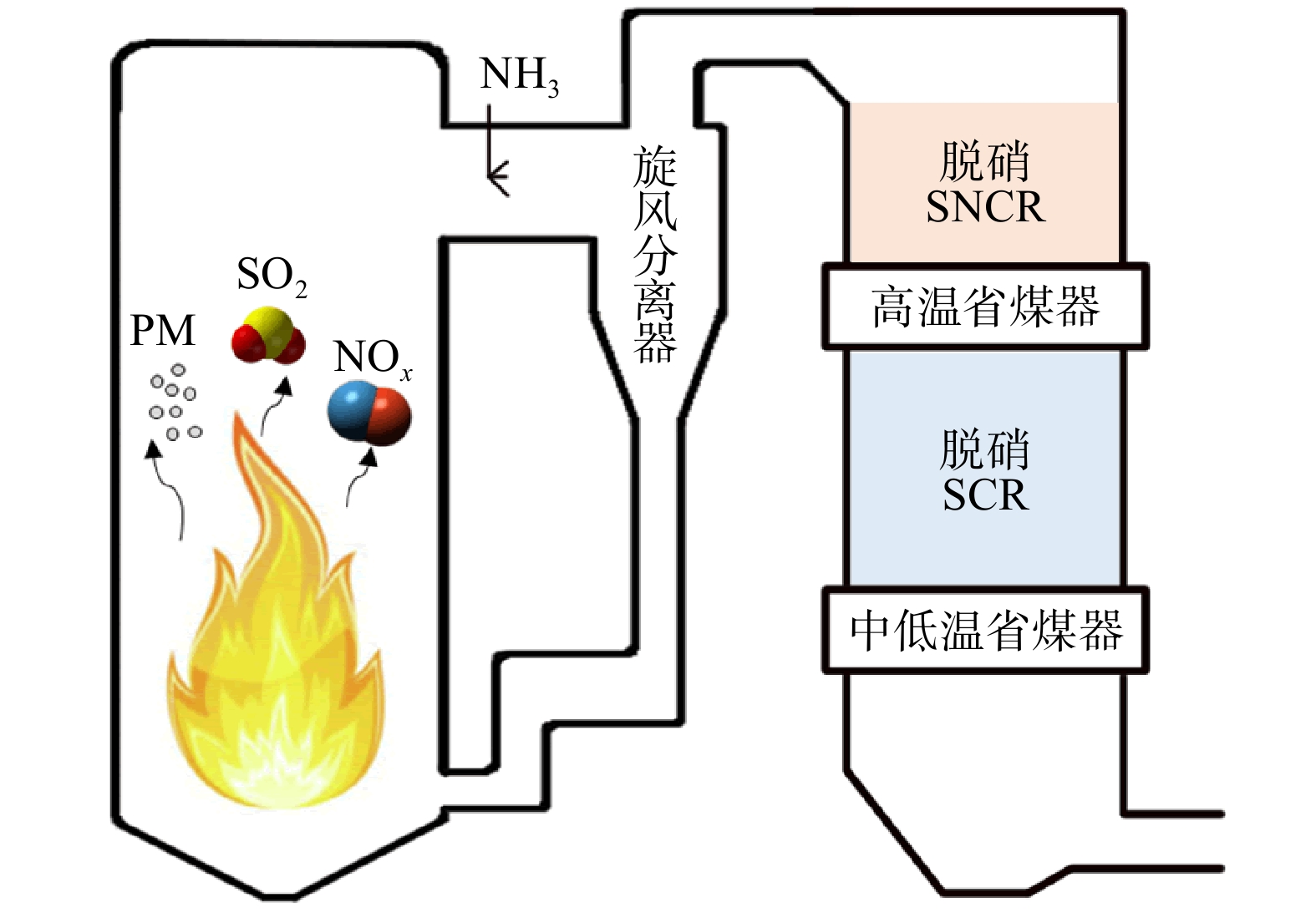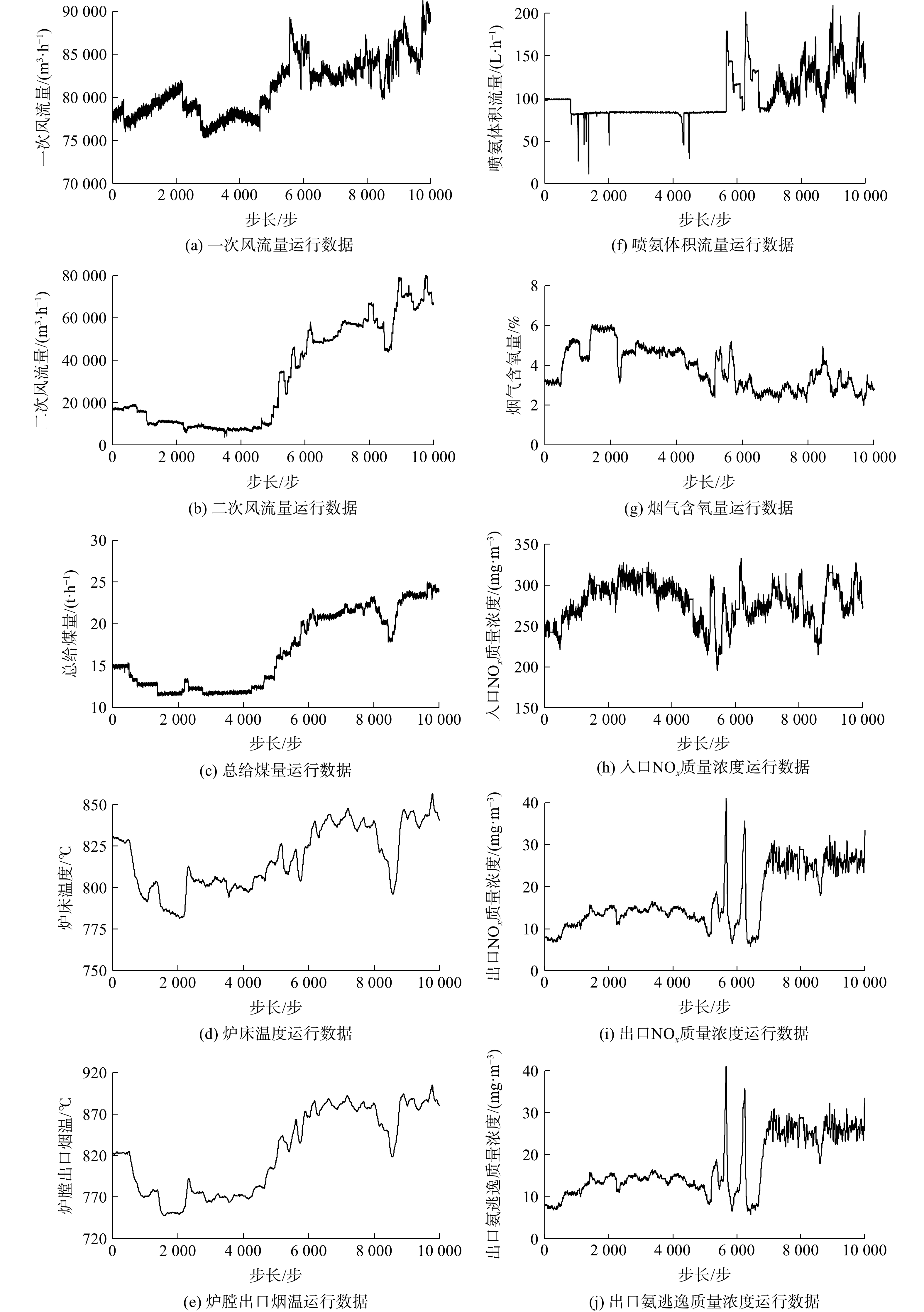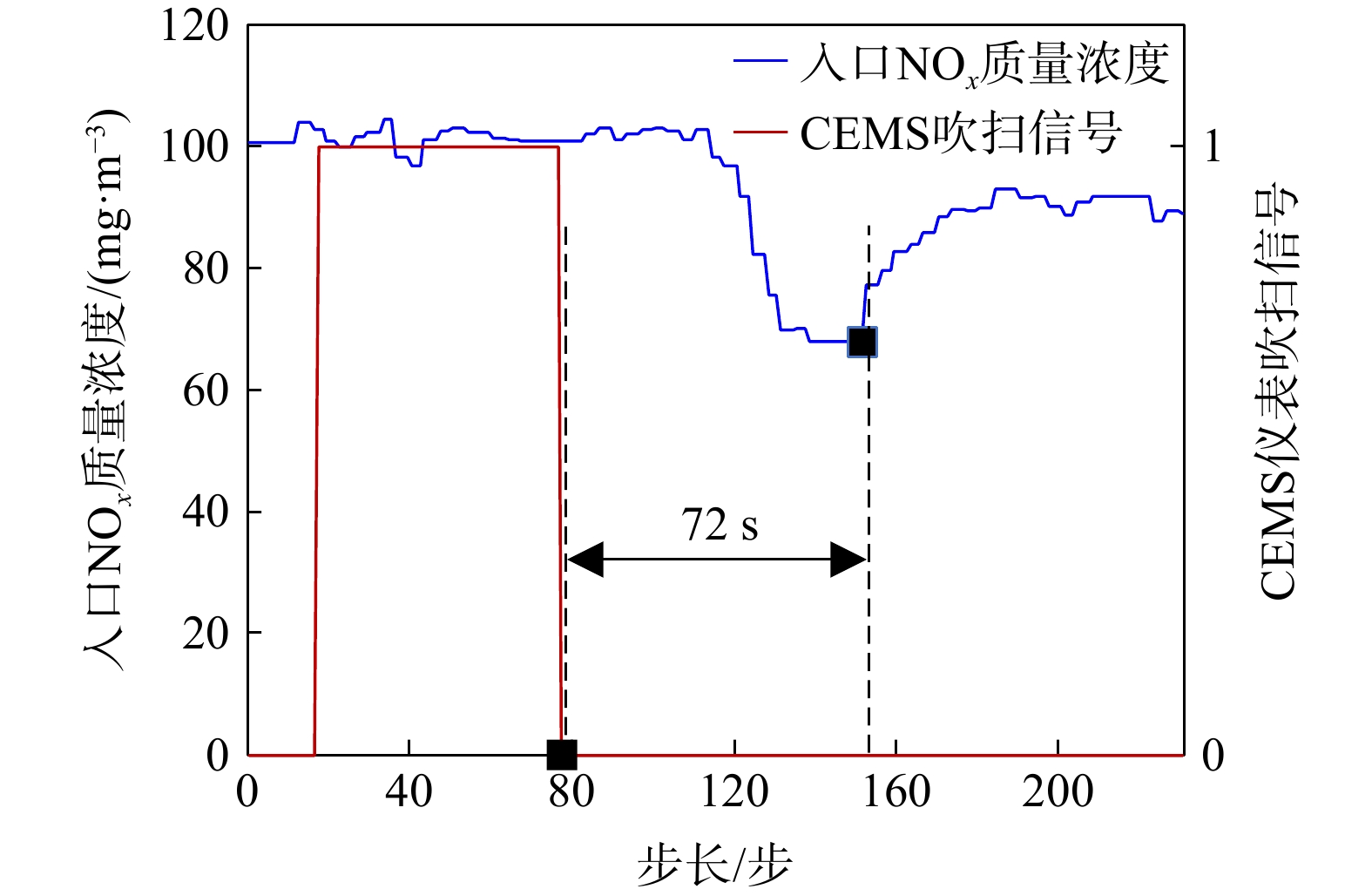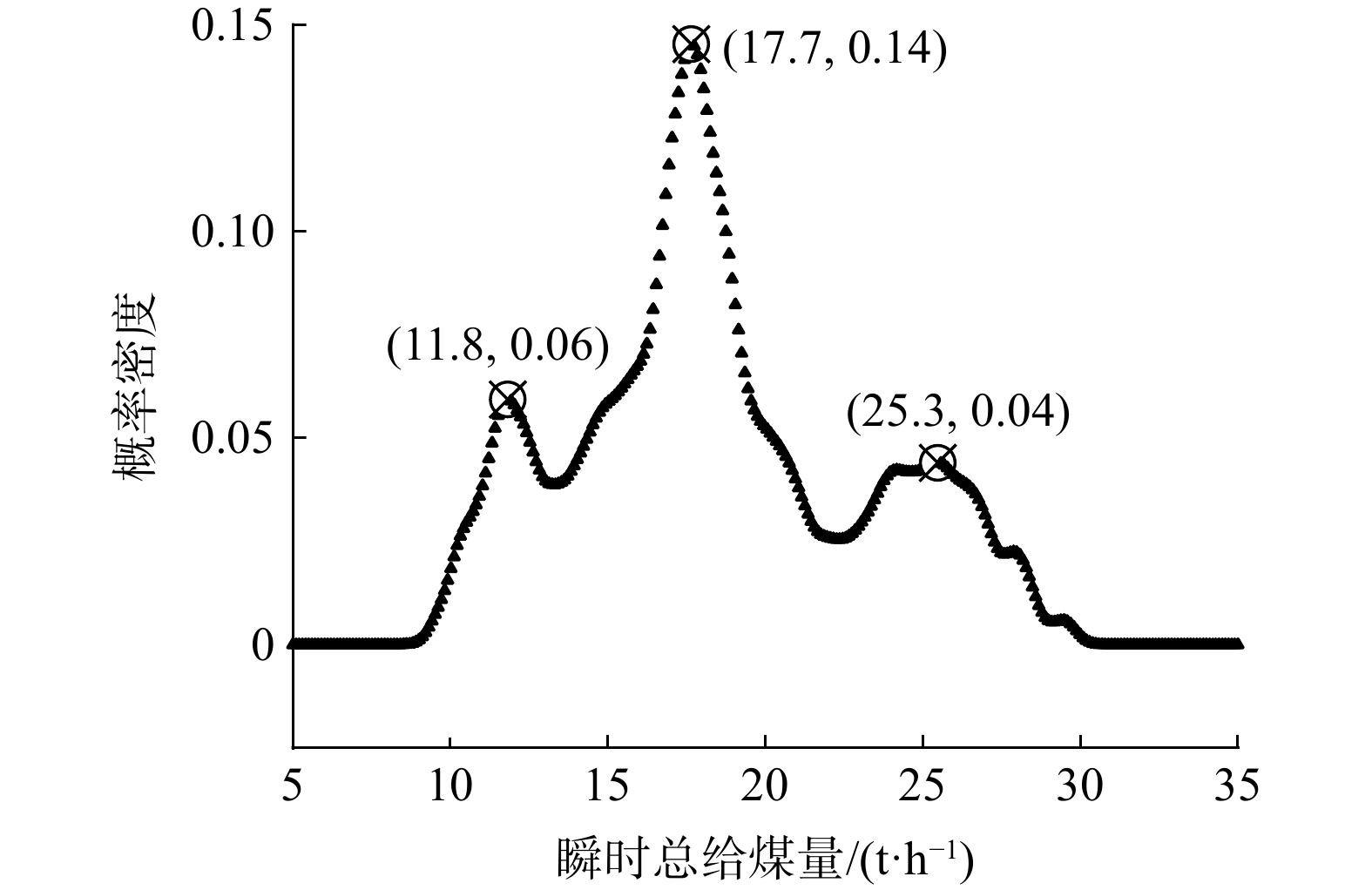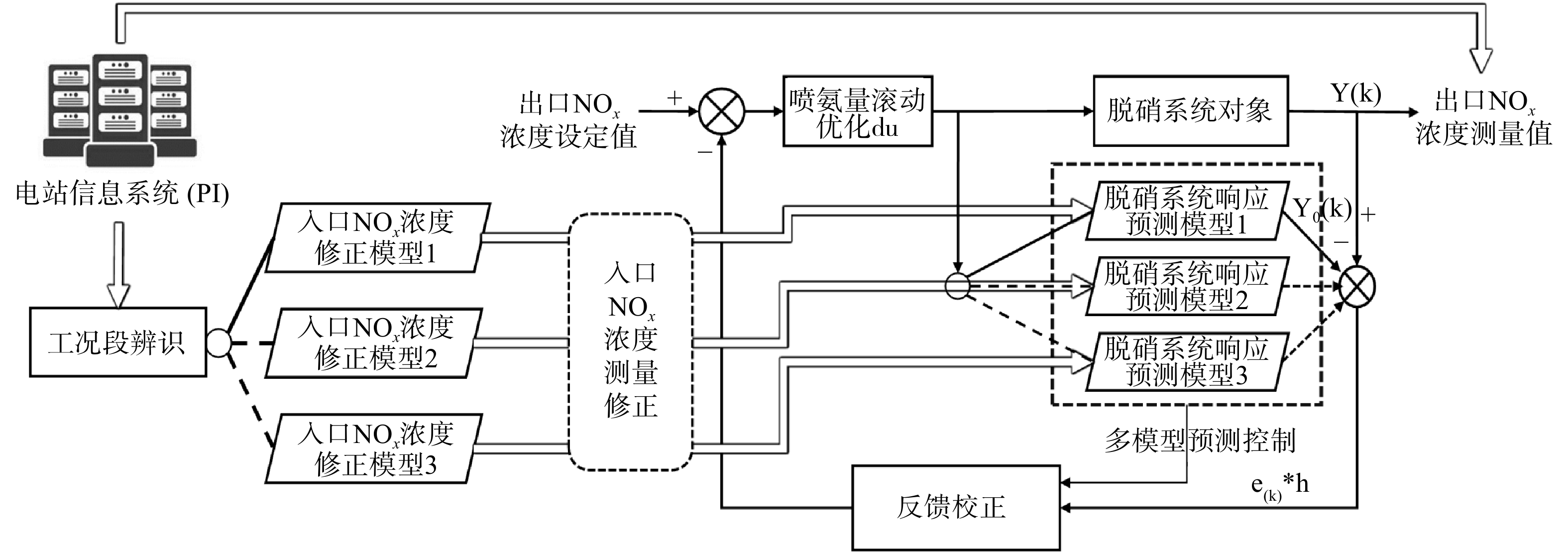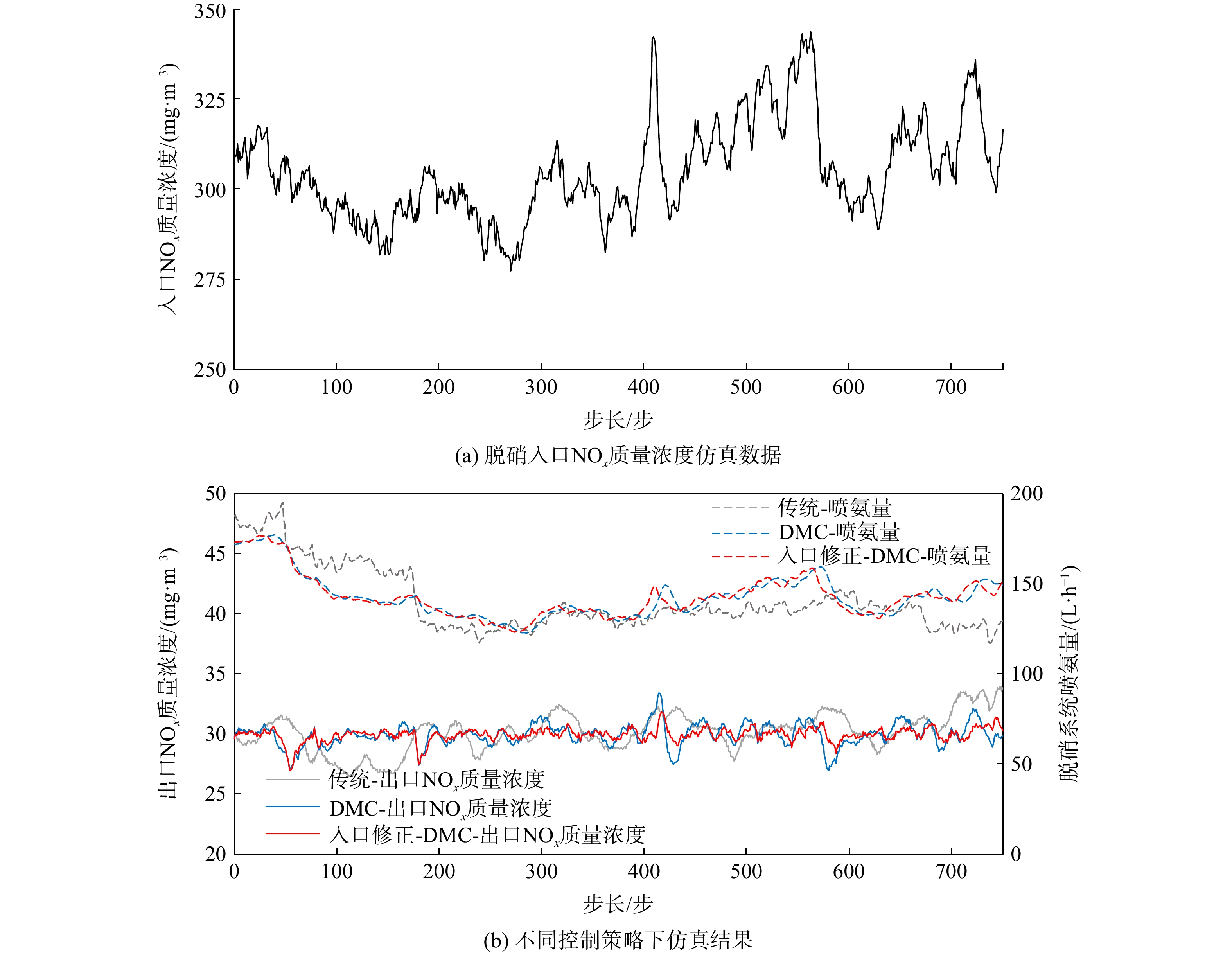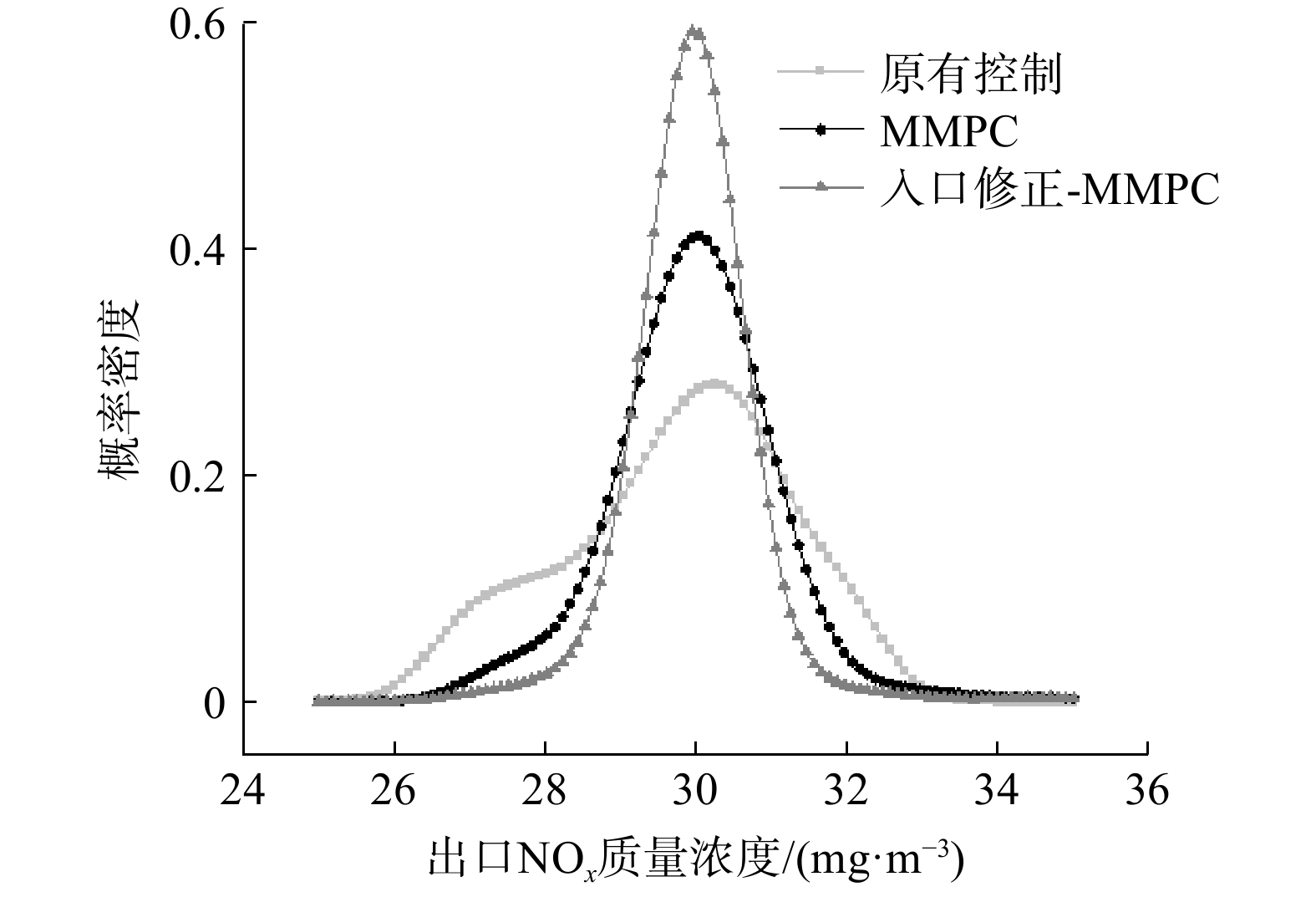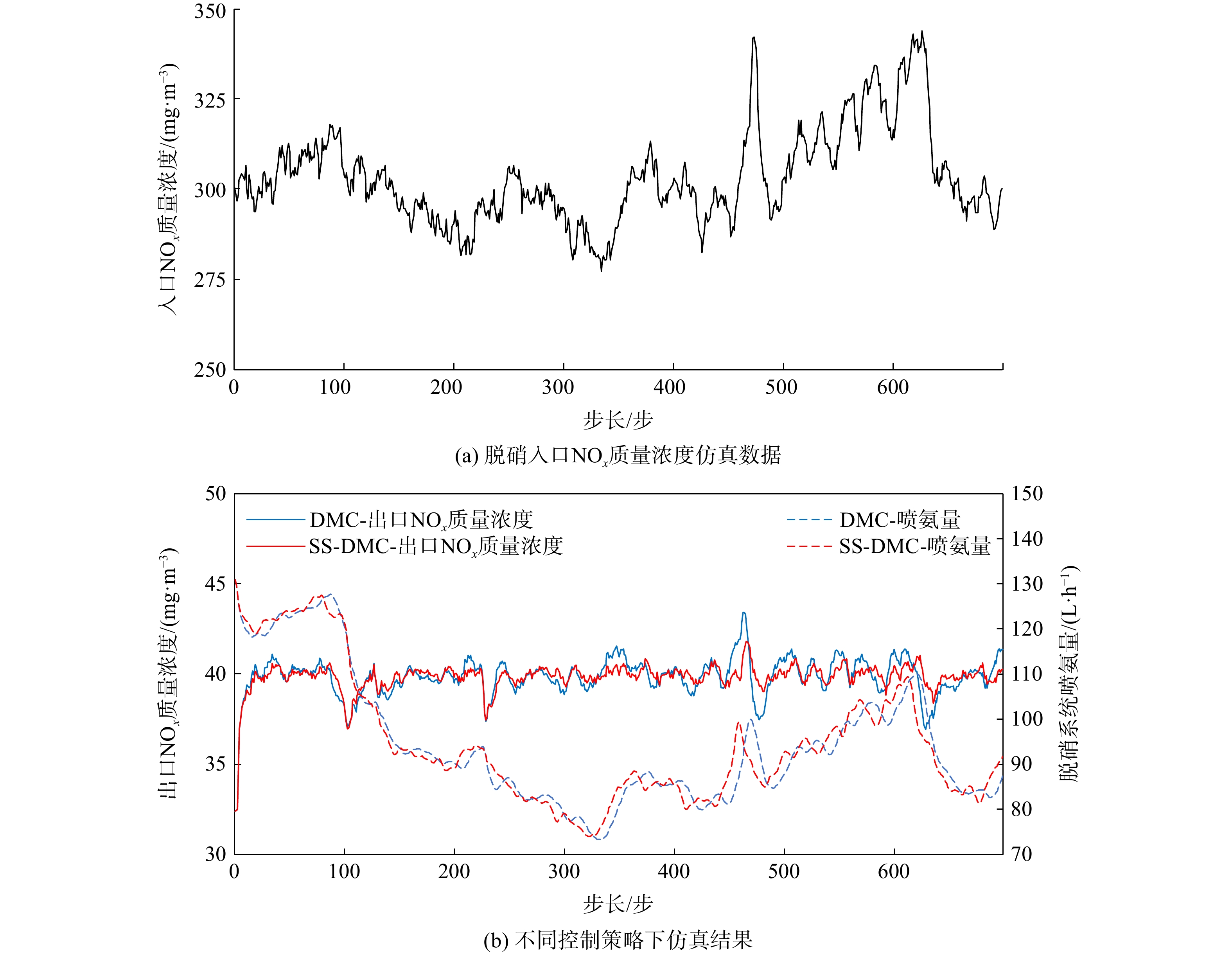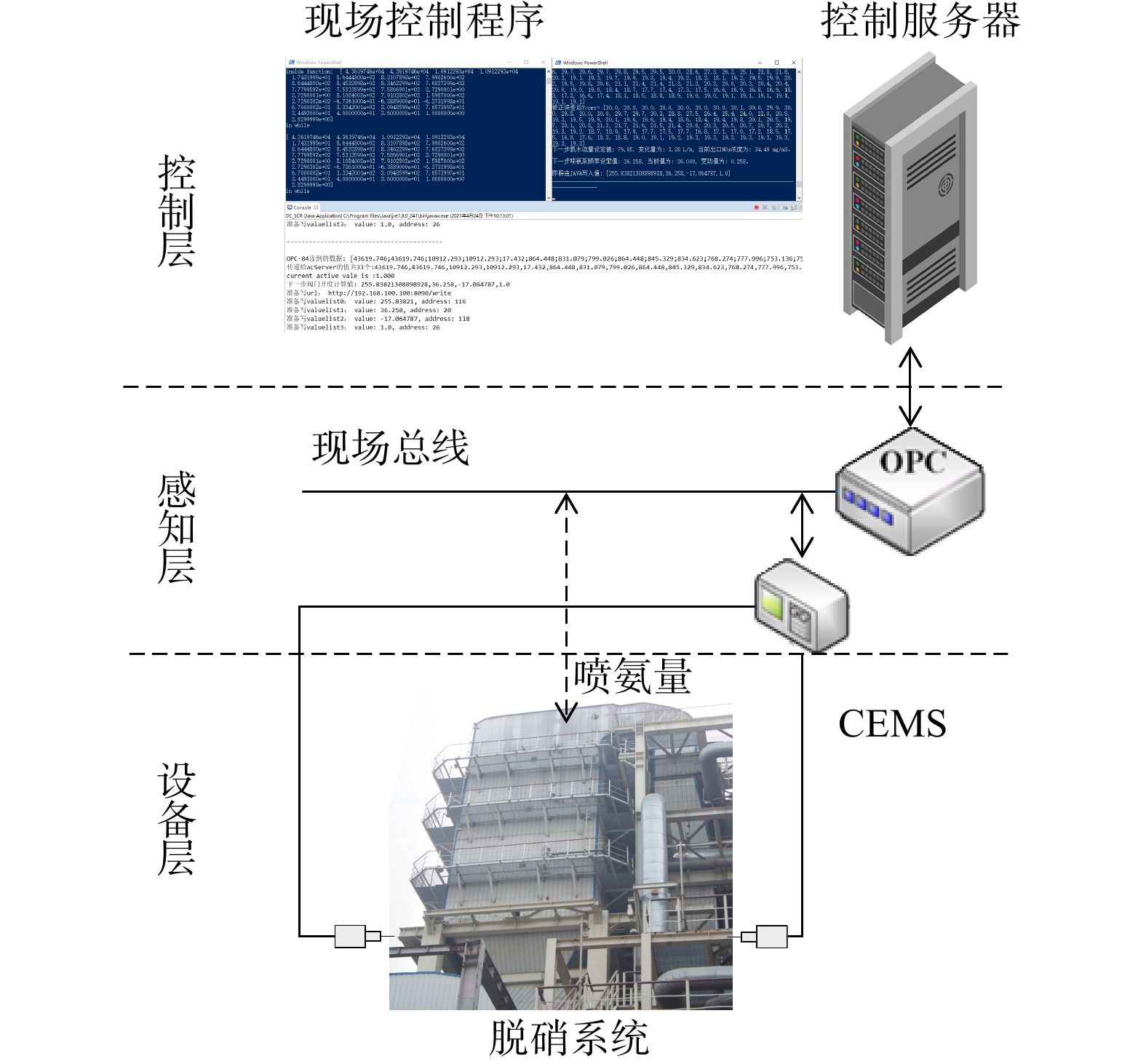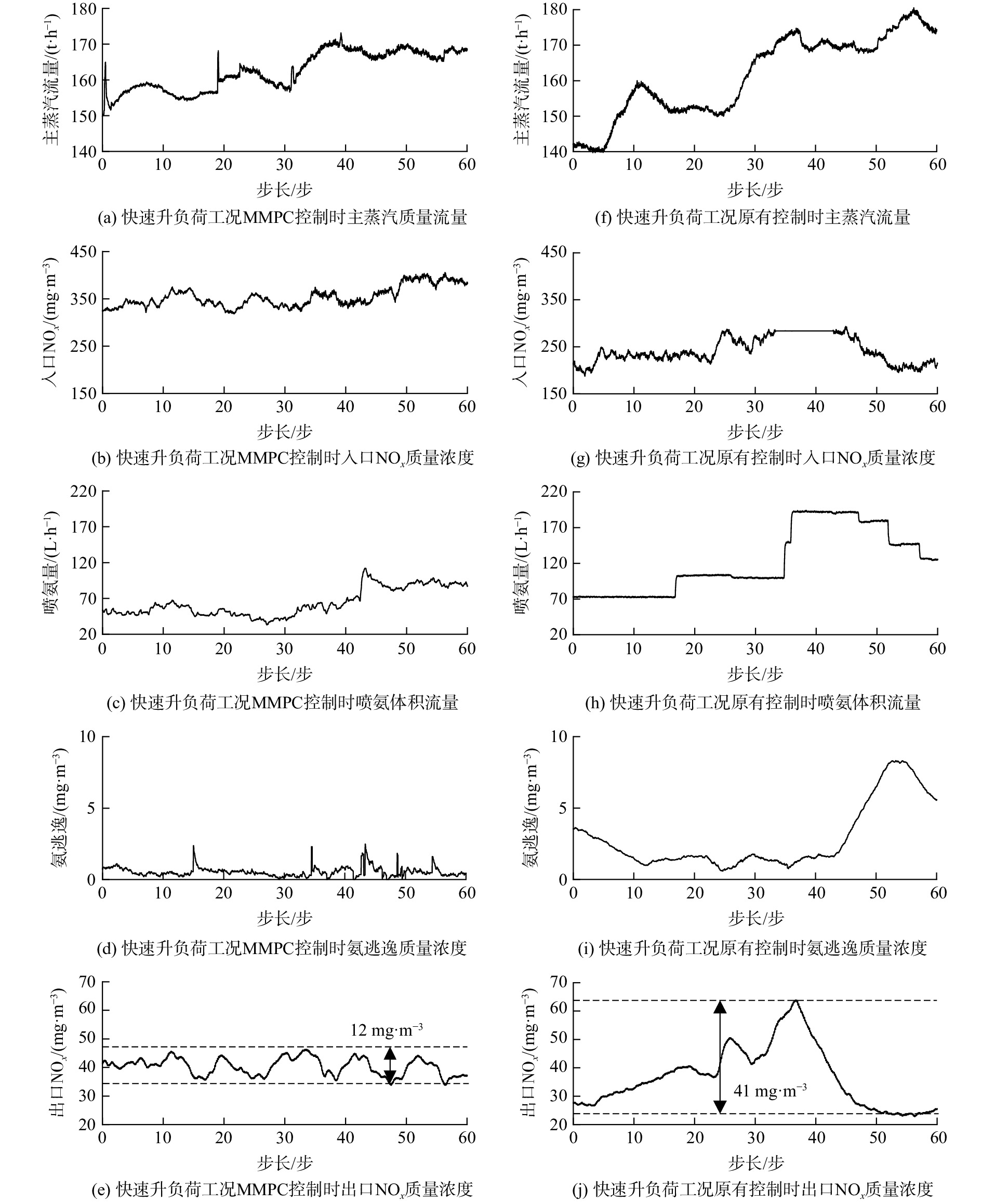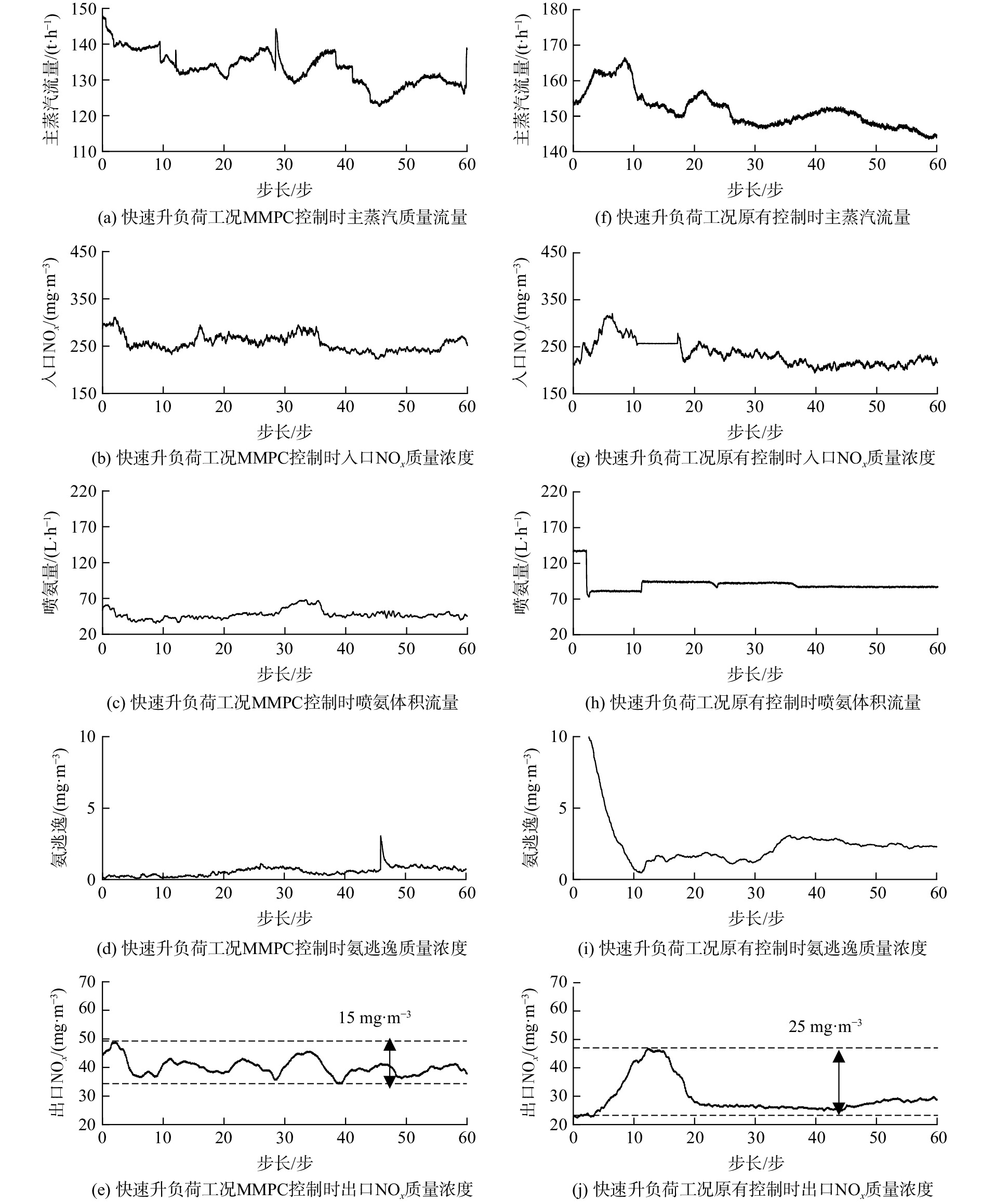-
煤炭燃烧会产生氮氧化物、二氧化硫和烟尘等污染物,对大气环境和人群健康造成危害[1]。2014年,国家发展改革委、环境保护部、国家能源局三部委印发《煤电节能减排升级与改造行动计划(2014—2020年)》。该计划旨在推进现役燃煤发电机组大气污染物达标排放环保改造,确保重点地区燃煤发电机组污染物排放达到燃气轮机机组排放限值[2],即排放的NOx质量浓度低于50 mg·m−3、SO2质量浓度低于35 mg·m−3、PM质量浓度低于5 mg·m−3。
近年来,循环流化床(circulating fluidized bed, CFB)技术得到发展并广泛应用。该技术具有燃料适应性强、燃料循环利用率较高、NOx排放量低的优点[3]。 为满足燃煤机组NOx排放限值,国内多家电厂对CFB机组开展了选择性非催化还原(selective non-catalytic reduction, SNCR)和选择性催化还原(selective non-catalytic reduction, SCR)联合脱硝技术改造。为满足NOx排放要求,河北省某330 MW循环流化床机组在原有低氮燃烧器+SNCR脱硝基础上,增设单层SCR催化剂,达到NOx排放低于50 mg·m−3的目标,且改造后还原剂使用量低于改造前,同时锅炉效率基本不受影响,实现了SNCR与SCR脱硝技术良好耦合[4]。邓志鹏等[5]采用SNCR/SCR联合脱硝技术对某220 t·h−1循环流化床锅炉进行改造,改造后机组可达到50 mg·m−3的排放标准,氨逃逸也控制在3×10−6以内。然而,SNCR/SCR联合脱硝系统存在入口NOx测量滞后性大、准确性差、系统非线性强[6],以及出口浓度测量值对于入口喷氨量反应迟等问题,导致现有控制系统难以精准控制喷氨量[7]。喷氨量过少会导致出口NOx质量浓度超出排放限制;喷氨量过多会出现氨逃逸并生成硫酸盐导致空预器、催化剂严重堵塞,对设备安全造成影响[8]。为保证出口烟气中NOx质量浓度的达标、降低氨逃逸量、提高脱硝系统运行的安全性和经济性,亟需研究入口NOx质量浓度滞后修正与喷氨量精准控制的方法。
在入口NOx质量浓度滞后修正方面,软测量作为一种间接测量技术发展迅速。孙璐培[9]利用最小二乘支持向量机(least square support vector machine, LSSVM)建立了多尺度分析的NOx排放软测量模型;ZHAI等[10]在考虑系统内各参数的延迟关系的基础上,采用自适应LSSVM模型实现入口NOx质量浓度的预测;TAN等[11]采用长短期记忆神经网络,搭建了电厂NOx质量浓度预测模型,通过敏感性方法分析影响NOx质量浓度变化的因素,但尚未摸清变工况下入口处NOx的快速变化情况。在喷氨量控制方面,石铙桥[12]研究了通过电厂历史运行数据辨识状态空间矩阵,实现SNCR脱硝系统喷氨量控制,但并未考虑入口NOx变化对系统的影响。刘博文[13]建立了带入口软测量的多模型预测控制器,但入口软测量模型并未与控制系统很好地结合起来。
本研究针对某CFB型机组的SNCR/SCR联合脱硝系统入口NOx质量浓度表计测量滞后,对锅炉总给煤量的典型历史运行工况进行数据聚类,建立了适应锅炉变工况下的全局LSTM神经网络预测模型,对入口NOx质量浓度进行滞后修正。在此基础上,提出基于入口NOx质量浓度修正的多模型预测控制策略,并进行现场工程应用验证,以期平稳控制脱硝系统出口的NOx质量浓度,减少氨逃逸,使脱硝系统运行更加经济、安全。
-
本文研究对象为一台燃煤循环流化床锅炉,供应的煤种煤质较为稳定,满负荷下蒸发量为220 t·h−1,采用SNCR与SCR耦合的脱硝系统。还原剂采用液氨,经过液氨蒸发装置蒸发后喷入炉内,与烟气中NOx进行还原反应,从而达到脱硝的目的。循环流化床锅炉结构如图1所示,建模所采用的主要参数如表1所示。
建立模型所需的数据由电厂信息(Plant Information, PI)系统采集。采样间隔5 s,采样周期20天,包含低、中、高多个负荷段,升、降、平稳负荷多种运行工况,数据一定程度上可覆盖电厂运行典型工况特征。部分现场数据如图2所示。
-
CFB锅炉脱硝系统入口NOx质量浓度通常由污染物排放连续监测系统(continuous emission monitoring system, CEMS)检测。从炉中抽气至就地分析腔中,通过CEMS分析烟气污染物成分信息。由于在抽气过程中,存在较长的抽气管路,再加上入口仪表分析反应时长,因此该系统滞后性较强,需要进行入口NOx质量浓度的滞后修正,再作为喷氨量控制的前馈信号,以提高系统在变工况下的响应速度。分析滞后时间的方法通常有计算法和信号分析法[14]。本研究采用信号分析方法,通过分析吹扫信号结束信号与NOx质量浓度测量值回升的时间差,得到CEMS测量滞后时间约为72 s(图3)。
-
由于脱硝系统具有很强的非线性特征[15],而动态矩阵的预测模型采用阶跃响应线性叠加的方式,仅通过一个动态矩阵模型去预测系统在整个工况区间上的响应较为困难。因此,本研究通过核密度估计方法确定系统运行的若干典型工况,并针对多个典型工况进行建模,以提高控制精度。核密度估计方法如文献[16]所述,分析对象为可代表CFB锅炉运行特征的瞬时总给煤量。对20 d总给煤量的采样数据进行核密度估计,结果如图4所示。11.8、17.7和25.3 t·h−1为历史运行工况中瞬时总给煤量核密度统计的3个概率密度极大值点,可代表此台锅炉运行的3个典型工况。后续入口NOx质量浓度预测模型与多模型控制器模型均建立在这3个典型工况点上。
-
有学者研究了脱硝系统入口NOx质量浓度建模的方法,包括机理建模[17-18]、CFD建模[19-20]和机器学习[11, 21-22]等。本研究采用长短期记忆(long short-term memory, LSTM)神经网络,预测未来70 s的脱硝入口NOx质量浓度与CEMS当前测量浓度值的差值。该方法优势有2点:一是可在神经网路训练过程中避免当前测量值作为输入值时权重占比过大的影响;二是可避免因CEMS仪表吹扫时仪表测量值缺失带来的影响。
以总给煤量11.8、17.7和25.3 t·h−1为聚类中心,对历史数据进行欧式距离聚类,得到3个数据集,并分别采用LSTM进行训练,欧氏距离公式见式(1)。
式中:x、y分别表示2个样本点数据;d表示欧氏距离;n表示样本数量。
-
LSTM网络训练数据采样间隔为20 s。采用2个隐藏层结构,回看时间步长(look-back timesteps)为24步,预测时间步长(prediction timesteps)为4步,训练数据与测试数据比例为0.8:0.2。为验证LSTM神经网络预测效果,与几种主流的机器学习预测方法的结果进行了对比,(表2)。LSTM在RMSE指标及相关性指标(R squared, R2)上结果均优于其他模型,且满足作为控制前馈的要求。
-
由于传统控制手段控制的脱硝系统在工况波动较大情况下时,会出现喷氨响应滞后、出口NOx质量浓度波动较大的问题,控制品质难以得到保证,故本研究基于上述入口NOx质量浓度测量修正为前馈的多模型预测控制(multi-model predict control, MMPC)策略,结果如图5所示。基于Simulink开发了脱硝系统仿真,并与无入口浓度修正的多模型预测控制及原有控制策略效果进行对比。
-
动态矩阵模型预测控制(dynamic matrix control, DMC)为模型预测控制的一种,主要分为模型预测、滚动优化和反馈校正3个部分[23]。其中,模型预测采用阶跃响应模型,可用一阶惯性系统模型(式(2))。
式中:Kp代表比例环节,Tp代表响应环节,Td代表纯滞后环节。采用动态惯性权重[24]的改进型粒子群寻优算法(improved particle swarm optimization, IPSO),寻找在11.8、17.7和25.3 t·h−1这3种典型工况下的脱硝系统预测模型。动态惯性权重调整后的公式为式(3)。
式中:w为惯性权重;R为当前迭代次数;Rmax为最大迭代次数。
各参数辨识结果及模型预测效果分别如表3和图6所示。这表明在各典型工况段上,预测模型均有较好的拟合效果,可满足系统仿真要求。
-
基于Simulink仿真软件,采用上述辨识模型的参数结果,搭建了脱硝系统仿真平台,仿真系统如图7所示。该系统分为4个部分,电厂运行数据部分为从现场采集的总风量、入口NOx质量浓度、总给煤量数据按采样周期5 s输入仿真系统;脱硝系统仿真部分为基于脉冲响应模型的脱硝系统仿真模块,可计算出实际出口NOx质量浓度;DMC控制器部分为经典的DMC控制器,红色部分则是入口NOx质量浓度测量修正模块,给入上述LSTM神经网络所预测出的入口NOx质量浓度差值。
在控制出口NOx质量浓度为30 mg·m−3的目标下,采用实际现场运行数据进行脱硝系统喷氨量控制仿真,仿真时间步长为800步。控制效果对比如图8所示。当仿真时间步长为100~ 200步时,原有控制在入口NOx质量浓度下降时喷氨量响应速率较慢,导致出口NOx质量浓度远离目标值,而MMPC控制器反应迅速。在仿真时间为400步和570步时,入口NOx质量浓度变化幅度较大,MMPC控制平稳性优于原有控制,而带入口NOx质量浓度修正的MMPC控制器波动幅度更小。将上述控制结果绘成频率折线图(图9)。结果表明,有入口浓度修正的MMPC控制平稳度优于普通MMPC控制,更优于原有控制。原有控制、MMPC与入口修正MMPC出口NOx质量浓度标准差分别为1.617、0.955、与0.584 mg·m−3。较原有控制,MMPC控制波动减少40.6%,入口修正MMPC控制波动减少63.7%。
-
控制出口NOx质量浓度平稳的目的有2点:一是尽量减少脱硝系统出口氨逃逸,降低出口氨腐蚀对设备造成破坏的风险;二是减少喷氨量,提高运行经济性。在该前提下,将出口NOx质量浓度设定值提高至40 mg·m−3,以观察系统响应。
图10表明,前80步为目标值30~40 mg·m−3的过渡过程,在出口NOx质量浓度抬高至40 mg·m−3后便不存在太多超调过程即往回回落,并稳定在40 mg·m−3附近。在480步入口NOx质量浓度有较大变化时,不带入口NOx质量浓度修正的MMPC控制波动范围为37.5 ~ 43 mg·m−3,而带入口NOx质量浓度修正的MMPC控制波动范围为39 ~ 42 mg·m−3,范围更窄。在入口NOx质量浓度波动较大的情况下,带入口NOx质量浓度修正的MMPC控制出口NOx质量浓度稳定在40 mg·m−3左右,表现出良好的控制品质。
-
为检验控制策略在实际应用中的效果,开发了与燃煤CFB机组现场生产环境兼容的脱硝控制系统,并在浙江嘉兴某热电厂开展了48 h的现场测试,期间经历了快速升、降负荷及高、中、低不同负荷的各种典型工况。现有控制系统部署在独立的网络系统中,电厂原有控制系统通过OPC交换机向现有控制系统传输数据,优化计算后的控制指令和相关数据再通过Modbus协议传输给DCS系统,实现智能控制。图11为现场部署的脱硝控制系统硬链接示意图。
在脱硝入口NOx质量浓度修正方面,当风、煤等参数发生较大波动时,入口NOx质量浓度预测修正可提示预判变化趋势,作为前馈使喷氨量提前动作。图12表明,在第1 000 步和第2 500 步左右时,模型分别判断出较大的上升趋势和下降趋势。但在较为平稳工况下的修正效果仍有待改进,这是由于输入模型的关键参数煤质信息有缺失,且修正模型无法完全反应生成的细节变化、未考虑流场中NOx分布不匀等问题。
在脱硝系统出口NOx质量浓度控制方面,主要从2个方面进行验证:一是控制系统在机组快速升降负荷情况下的控制效果,检验控制的快速性、平稳性;二是检验在不同负荷段的控制效果,检验多模型策略的可行性和系统的鲁棒性。图13为快速升负荷下的控制效果对比,原有控制出口NOx波动范围为±21 mg·m−3,而入口修正-MMPC出口NOx波动范围为±6 mg·m−3。而且原有控制滞后,在出口NOx超过50 mg·m−3后才调大喷氨量,导致了喷氨过量,氨逃逸达到8 mg·m−3,而入口修正-MMPC喷氨量提前动作,将氨逃逸维持在了3 mg·m−3以内。图14为快速降负荷时控制效果的对比,原有控制的出口NOx波动达到了±12 mg·m−3,而入口修正-MMPC出口NOx波动控制在±5 mg·m−3内,故氨逃逸也较低。
为验证控制模型在全局工况下的鲁棒性,对高、中、低负荷工况下的控制效果进行对比(表4)。统计现场实验数据和历史数据在相应负荷段的1 h内,出口NOx质量浓度及氨逃逸的最大值、最小值和标准差统计量,用以表征控制效果好坏。在出口NOx质量浓度控制方面,在同样设定值35 mg·m−3的情况下,入口修正-MMPC控制在各工况段始终控制出口浓度低于40 mg·m−3,实现了较好地卡边控制。而原有控制波动较大,甚至有超标的风险。在氨逃逸控制方面,入口修正-MMPC控制氨逃逸最大值也小于原有控制水平,标准差上更是有巨大差距。这也说明入口修正-MMPC控制更为平稳,氨逃逸值波动较小,使脱硝系统的平稳性和经济性均有明显改善。
综上所述,入口修正-MMPC策略在升降负荷工况下响应较快,出口NOx质量浓度控制平稳,氨逃逸较低。由于多模型的应用建立了准确的全局预测模型,在高中低典型工况上预测模型均有较高的准确性、鲁棒性好,因此可满足长期运行要求。相较于原有控制,入口修正-MMPC可有效降低出口NOx质量浓度的波动,减少过量喷氨次数,降低氨逃逸,节约氨水使用量,从而提升脱硝系统运行经济性、安全性。
-
1)由于不同工况聚类的长短期记忆神经网络模型的准确度要高于常见的回归模型人工神经网络和随机森林回归,故在脱硝入口NOx质量浓度修正方面,可证明长短期记忆神经网络在处理时间序列数据上的优势。模型在测试集上的均方根误差为3.53 mg·m−3,相关性系数为89%。
2)在喷氨量控制方面,采用多模型预测控制策略,可克服脱硝系统非线性特性强的问题,增强控制系统在不同工况下的鲁棒性。采用入口浓度修正的多模型预测控制策略,可使控制系统在入口NOx质量浓度发生突变时,喷氨量提前动作响应,相比没有入口修正的多模型预测控制策略,出口NOx质量浓度控制更平稳。
3)现场应用表明,脱硝系统采用入口浓度修正的多模型预测控制策略后,在变工况和高、中、低多负荷区间条件下,出口NOx质量浓度波动明显降低。这表明多模型预测控制策略下系统的运行优于原有控制策略,该策略亦可提高脱硝系统的经济性。
基于入口NOx质量浓度修正的脱硝系统多模型预测控制策略及其应用案例
Multi-model predictive control of denitrification system based on modification of inlet NOx mass concentration and its application case
-
摘要: 建立不同锅炉工况下基于欧式距离聚类的总给煤量长短期记忆神经网络预测模型,对入口处的NOx质量浓度数据进行修正,其验证集上的均方根误差为3.53 mg·m-3。该结果优于常见的回归方法深度神经网络与随机森林回归的预测结果。以此为基础,研究了基于入口NOx质量浓度修正的多模型预测控制(MMPC),设计并进行了脱硝系统仿真。仿真结果表明,与原有控制条件相比,基于入口NOx质量浓度修正的MMPC策略使脱硝系统出口NOx质量浓度波动幅度减小了63.7%,并能满足出口质量浓度指标为40 mg·m-3时的控制要求,实现卡边控制。现场工程应用结果表明:在高、中、低负荷正常运行的工况条件下,入口修正-MMPC策略可将出口NOx质量浓度波动分别控制在±10.6 mg·m−3、±5.5 mg·m−3、±4.9 mg·m−3,以标准差来衡量波动幅度即分别减小了53.4%、74.7%、64.6%,此控制水平优于原有控制效果;在出口NOx质量浓度易超标并出现高浓度氨逃逸的快速变负荷工况下,升、降负荷出口NOx质量浓度波动分别控制在±6 mg·m−3、±5 mg·m−3,此控制水平仍优于原有控制效果。本研究的入口修正-MMPC控制策略可实现不同负荷、工况下的喷氨控制,减小出口NOx波动幅度,降低后续设备低温腐蚀的风险,从而提高SNCR/SCR联合脱硝系统运行的经济性和安全性。
-
关键词:
- 选择性非催化还原和选择性催化还原联合脱硝 /
- 循环流化床 /
- NOx质量浓度测量修正 /
- 多模型预测控制 /
- 超低排放
Abstract: A composite long short-term memory neural network was trained to correct the lag of inlet NOx mass concentration, on dataset divided by the Euclidean distance of the total coal supply of the boiler under typical working conditions. The root mean squared error on the verification dataset was 3.53 mg·m−3, which was better than the prediction results of common regression methods, such as deep neural network and random forest regression. On this basis, the Multi-model Predict Control (MMPC) strategy based on the correction of the inlet NOx mass concentration was studied, and the denitration system simulation was designed and carried out. The simulation result shows that compared with previous control, the MMPC with inlet NOx mass concentration correction makes the fluctuation range of outlet NOx mass concentration reduced by 63.7%, and it can also meet the control requirements when setting outlet mass concentration at 40 mg·m−3. The results of field application indicated that under operation conditions of high, medium and low load, the MMPC with inlet NOx mass concentration correction can control the outlet NOx mass concentration fluctuation between ±10.6, ±5.5 and ±9 mg·m-3, and the fluctuation range was reduced by 53.4%, 74.7% and 64.6% respectively by standard deviation. Then, under the condition of fast variable load, it is easy to happen that emission of NOx mass concentration at the outlet exceeds the standard and ammonia escapes at high concentration. However, the fluctuation of NOx mass concentration at the outlet of load up and load down coditionis controlled respectively within ± 6 and ±5 mg·m−3 by MMPC with inlet NOx mass concentration correction. It proves that the control performance is better than the original control effect. Above all, under different loads and operation conditions, the MMPC with inlet NOx mass concentration correction strategy studied in this paper can well control the amount of ammonia injection, reduce the fluctuation of NOx mass concentration at the outlet, minimize the risk of low temperature corrosion of subsequent equipment, and consequently improve the economy and safety of SNCR/SCR coupling denitration system. -
2015年4月,国务院颁布《水污染防治行动计划》(水十条),确定我国水污染防治目标[1]:即2017年底前,直辖市、省会城市、计划单列市建成区基本消除黑臭水体;到2020年,地级及以上城市建成区的黑臭水体均控制在10%以内;到2030年,城市建成区黑臭水体总体消除。2015年9月,住建部发布《城市黑臭水体整治工作指南》(“工作指南”),提出“控源截污、内源治理;活水循环、清水补给;水质净化、生态修复”是城市黑臭水体整治的基本技术路线[2-3]。
暴雨径流产生的城市面源污染是城市水体重要污染源,污染负荷可占10%以上[4]。暴雨初期雨水流量大,且往往含有大量污染物[5-6]。城市排水管网建设和改造滞后,许多老城区排水管网难以进行分流制改造,使得许多城市将长期面临城市面源导致的水体污染问题。以黑臭水体治理为目标,开发针对城市面源初期雨水的快速高效一体化设备,尽可能削减入河污染负荷,对于维持城市河湖水体水质安全和水生态功能具有重要意义。
超磁分离即在污水中投加磁性物质,使不带磁性的污染物被赋予磁性,再通过磁性设备实现固液分离,达到水体净化的目的。笔者团队基于超磁技术,自主研发了超磁分离水体净化技术和成套设备,在国内多个黑臭水体治理工程中得到成功应用。本文介绍超磁分离装备的技术原理和设备概况,通过梳理其在黑臭水体治理各环节的应用工程,总结了其停留时间短、净化效率高、容积负荷高、高度集成化等工艺特点。该技术在实际工程应用中可因地制宜设计、快速投产应用,可为河湖水体质量改善、功能恢复和水生态健康提供参考。
1. 超磁分离技术的工艺原理及流程
1.1 工艺原理
污水中存在大量质量较轻的胶体和细小悬浮物颗粒。这些微小物质在水中受水分子热运动的碰撞而做无规则布朗运动。其中,悬浮颗粒都带有同性电荷,颗粒间的静电斥力阻止其彼此接近,而不能聚合成较大颗粒;胶体中带电荷的胶粒和反离子易与周围水分子发生水化作用,在其外层产生水化壳,阻碍胶体间的聚合。胶体的胶粒带电越多,其电位就越大;扩散层中反离子越多,水化作用也越大,水化层也越厚,因此扩散层也越厚,稳定性越强[7]。
超磁分离水体净化技术即向污水中投入磁粉和混凝剂,降低或破坏污水中胶体的电位降,从而破坏颗粒稳定态(即脱稳);脱稳的颗粒聚集成为较大颗粒,形成以磁粉为核心的微絮团;再通过高强磁场力作用至微絮团中的磁粉,使微絮团克服流体阻力和自身重力,快速定向运动并吸附至磁盘表面;然后用设备的卸渣装置将泥渣与水体分离,实现水质的净化;最后,再将磁性污泥送至磁粉回收设备中,以实现磁粉与污泥的分离。分离出来的磁粉可返回前端循环利用,参与下一次水质净化过程;分离出的非磁性污泥因其含水量较低,无需浓缩即可送至脱水系统处理,脱水后的干泥外运处置。超磁分离技术的基本原理如图1所示。
1.2 工艺流程
超磁分离技术工艺流程(见图2)有4步:1)污水经提升或自流进入混凝反应器,并投加一定浓度的磁粉充分混合;2)在混凝剂和助凝剂作用下,水体中的磁粉与非磁性悬浮物相结合形成微磁絮团;3)混凝反应后的污水自流入超磁分离设备,通过高强度磁场的作用,形成磁性微絮团,再从磁盘打捞出水,使微磁絮团与水体分离开,出水可排放或进入下一步工艺;4)从磁盘分离出来的微磁絮团通过磁回收系统处理,将磁粉和非磁性污泥分离开,磁粉可循环再利用,污泥则进入下一步的污泥处理系统。
1.3 技术优势
笔者团队经过多年实践,开发的集成处理设备在污水处理工程中展现了较好的应用效果,呈现5个方面的技术优势:1)磁粉加入后形成的带磁核的高密度均匀微絮团,提高了混絮凝反应的效率。该技术的分离效率为重力沉淀法的数百倍,在4~6 min内即可实现较好的处理效果;而反应时间仅为高密度沉淀及加砂沉淀技术的5%~10%;2)集成处理设备结构紧凑,占地面积小,为传统工艺的1/6~1/8。设备可用卡车装载,便于整体移动,应用灵活(见图3);3)系统的耐负荷和抗水量波动冲击的能力强,出水水质较好,SS去除率能达到90%~95%,藻类去除率≥95%,TP去除率为80%~90%,COD去除率为40%~60%;4)集成设备的自动化程度高,运行费用低,磁种回收率可达98%以上。系统装机容量小,耗电量低,低碳节能;5)从污泥处理的角度来说,工艺的排泥浓度高,含水率≤95%,在无需浓缩的前提下即可直接进入脱水机处理[7]。
2. 超磁分离技术在黑臭水体治理中的应用案例
根据住建部“工作指南”指导意见,结合超磁分离技术和装备自身优势,提出黑臭水体治理的基本思路以及因地制宜、“一水一策”的应用策略,具体分为“控源截污”“内源治理”“活水循环”“清水补给”“水质净化、生态修复”等方面。
2.1 控源截污典型应用案例
针对排污口的直排污水、泵站(污水厂)溢流水、初期雨水及其他需应急治理的污水问题,采取截污净化的方式,从源头上控制污染物进入水体,实现清水入河。控源截污和内源治理是消除黑臭水体的基础与前提[2]。其中,“控源”的对象包括未纳管直排污水、初期雨水、泵站(污水厂)溢流水以及应急排污等,以下为应用案例。
2.1.1 未纳管直排污水处理的应用案例
北京清河沿岸有多个污水直排口(如图4),未经处理的污水直排入清河导致河水发黑发臭。水体质量差不仅使周围居民的生活环境变差,还进一步污染河道周边的土壤及地下水。经调研,清河沿岸的污水直排现象有:城中村污水直排、管网未覆盖地区的雨污合流排污、采沙场洗砂废水直排等。结合项目实际情况,采取建设临时治污工程措施来治理因直排导致的黑臭问题。
根据调研情况,最终确定沿岸建设3个应急治理站:河北村应急治理站,处理规模为2 000 m3·d−1;外环跌水闸应急治理站,处理规模为20 000 m3·d−1;沙总排排污口应急治理站,处理规模为15 000 m3·d−1。工程以去除黑臭、提升感官效果为目标,设计采用流程简单、占地面积小、工程建设周期短、启动迅速、去除效率较高的超磁净化处理工艺,达到了初步改善城区段清河水环境质量的目的。建成后,每年可削减2 210 t悬浮物、1 530 t有机污染物(以COD为指标)和18 t含磷污染物(以TP为指标)。治理后出水效果如图5所示。
对于类似情况的未纳管直排污水,可以采用一体化超磁分离设备临时应急处理的方式,即能快速响应、应急治理,待管网完善、污水纳管处理后,设备还可以挪至其他地方继续使用。
2.1.2 初期雨水处理的应用案例
江西省萍乡市中心城区人口密集,部分排水管为合流制,存在排水管径较小,管材严重老化且排水系统不全的情况。由于城区排水不畅,部分地区常受内涝之灾。为解决城区现状积水较严重的路段排水及近几年即将实施的道路排水问题,对萍乡市西门内涝区进行综合整治。
综合整治工程内容包括在萍乡市公交西站内修建3#和4#调蓄池储存初期雨水。由于在降雨初期,雨水溶解了空气中大量的污染性气体,降落地面时,又冲刷屋面、道路等固化面,所以初期的雨水中含有大量污染物。晴天经雨污合流制管道外排时又混入大量生活污水,使得调蓄池储水中混入大量污染物。若未经处理直接外排,会给水环境造成严重污染。由于此次整治为老城区改造,可用地面积极其有限。故将初雨净化站点设置在小西门桥头处三角地带,实际可用地面积仅260 m2。
经比选,最终采用处理能力10 000 m3·d−1,占地面积仅有113 m2的集成式超磁分离设备(见图6)。设备运行至今,已实现对调蓄池排水的长期处理。设备长期进水水质指标平均值:SS为180 mg·L−1,COD为100 mg·L−1,TP为2 mg·L−1。出水水质指标平均值:SS小于20 mg·L−1,COD小于50 mg·L−1,TP小于0.5 mg·L−1。水中污染物被大幅削减,就近排入河道,亦可对其进行补水,以改善河道水环境。
对于海绵城市的“渗、滞、蓄、净、用、排”,超磁分离可利用自身占地面积小、处理效率高的优势,配套调蓄池,针对海绵城市的“蓄、净”2个环节有效结合,对初期雨水收集净化处理后外排。
2.1.3 泵站(污水厂)溢流水处理的应用案例
杭州市余杭区及临平副城污水处理系统的污水输送泵站长期高水位运行,致使地势低洼地段经常发生污水满溢现象。溢流污水通过雨水管排入河道,导致河道水质变差。余杭区政府拟对区域内管网进行升级改造。管网建成前,需采用应急处理的方式将各泵站超量污水中的污染物进行快速削减,然后再外排。为避免污水溢流对河道造成污染,应急处理设施需赶在汛期来临前建设完成,并通水运行。
为节省投资、保证项目工期,拟将应急处理设备布置在各泵站旁,故需选用建设周期短、占地面积小、可移动式的工艺设备。经比选后,最终选用集成式超磁分离设备,对溢流污水中的污染物进行快速削减。污泥采用吸粪车定期送至污水厂集中脱水处理。该项目共建设6个站点,总规模9.5×104 m3·d−1。项目在30 d内(含土建)即建成通水,体现了超磁分离设备建设周期短、占地面积小、出水效果稳定的优势。近年来,浙江省提出“五水共治,治污先行”的水环境改善路线。余杭区的污水量也逐年增加。为提高区域内各污水应急治理点的处理能力,并确保达标排放,决定通过改造和新建应急处理点,使外排水质达到《城镇污水处理厂污染物排放标准》一级B标准。
在对乔司永玄路站点进行提标改造中,系统出水主要考核指标有COD、NH3-N、SS、TP。现有超磁分离工艺为物化处理方法,主要去除水中SS、TP及悬浮性COD。因此,为进一步去除水中COD、NH3-N等污染物,需增加二级生物处理段。经工艺比选,最终选用“超磁分离技术(现有)+无堵塞曝气生物滤池”。无堵塞曝气生物滤池采用独创的气水分布滤砖技术,克服了传统曝气生物滤池滤头易堵塞的问题,是一种新型生物膜法污水处理滤池系统。
系统处理规模为2×104 m3·d−1。由于项目性质为应急治理,工期紧,滤池主体结构采用钢材焊接而成(设计效果图见图7),45 d实现通水调试。系统正常运行后,出水优于《城镇污水处理厂污染物排放标准》一级B标准(TN指标除外),系统进、出水水质见表1。
表 1 乔司永玄路站点进、出水水质的月均值Table 1. Influent and effluent quality of the Josi Yongxuan Road station mg·L−1项目 COD SS TP NH3-N 进水 200 218 4.6 60 出水 55 10 0.5 7 超负荷的泵站(污水厂)溢流水,在污水厂扩容工程建成前,可采用超磁分离设备进行临时应急处理;或采用“超磁分离+生化处理系统”,进行全指标处理。
2.2 内源治理典型应用案例
黑臭水体的内源治理即垃圾清理、清淤疏浚等处理措施。清淤疏浚主要清理底泥中的污染物。通过清除底泥,可实现黑臭水体内源污染负荷的迅速降低,减少底泥污染物向水体中的释放。底泥清理方式有机械清淤、水力清淤等。机械清淤产生的污泥经脱水后外运处置,滤液回灌至水体。由于滤液依然存在浊度、总磷等污染指标较高的问题,为避免滤液对水体造成二次污染,需同时配套滤液净化设备,对滤液净化处理后再排入水体。
四川省绵阳市木龙河流域中污染物超标严重。对该流域水环境特点和水质污染现状进行调研后发现,河道受到农田废水污染、村庄生活污水污染、沉积淤泥内源污染、缺乏生态基流等的影响。针对以上具体问题,采用“控源截污—内源清淤—超磁透析净化—原位生态修复”的技术路线。其中,需对2 km河段进行机械清淤,清淤厚度为0.2~0.3 m,淤泥量约为8 000 m3。清淤产生的污泥经脱水后用于绿化种植。滤液经净化处理后再回灌至河道。由于脱水后的滤液浓度高,且河边可用地面积小,故采用集成度高、处理效率高的车载移动式超磁分离设备。净化后滤液的SS低于20 mg·L−1、TP低于0.5 mg·L−1。清淤工作完成后,超磁分离设备可运至其他站点继续使用。
2.3 活水循环典型应用案例
对于断头河、胡泊等封闭水体,水体流动性差,易发生富营养化现象,变得浑浊不堪。严重时水体甚至变绿、变臭、发黑,影响水景观赏效果和周边生活环境。采取循环透析的方式,以快速削减水中污染物,提高水体流动性,从而实现水质长效保持。
北京总装航天城的人工湖湖区总面积有2×104 m2,湖区平均水深1.05 m,水体的总库容量为2.1 ×104 m3。由于水体流动性差,湖区水体浑浊不堪,透明度低(30~40 cm),亟需整治[4]。为提高水体流动性,采用超磁循环透析技术,从湖体一端取水,经超磁分离净化后,出水排至湖体另一端,以实现对湖水进行透析式循环处理,将湖水快速净化,并达到长效保持的目的。配合湖区生态修复技术,系统正常运行后,水质保持在《地表水环境质量标准》IV类水标准以上。项目现场照片如图8所示。
2.4 清水补给典型应用案例
针对景观用水、功能性用水等需要引水补给的情况,首先需要确保引水水源的水质达标,避免污染物进入后续用水段。
苏州市同里古镇家家临水、户户通舟。古镇里因水成街、因水成路、因水成市、因水成园。古镇景区内的水源为同里湖引水补给而入。近年来,由于古镇周围工业和生活污水部分排入同里湖,湖区内累积了大量污染物。同里湖水体的自净能力已不能保证湖区水质,导致水体发生富营养化,产生臭异味,导致景区内水体透明度和感官效果日益下降。春夏季水体中蓝藻滋生,影响到景区水环境观感。
为改善水质现状,恢复、保持水乡特色,通过大量调研、试验和技术论证,最终选用单套处理能力大(3.6×104 m3·d−1)、后期运行成本低(每吨水0.18元)、占地面积小(336 m2)、出水效果稳定的超磁分离水体净化成套工艺技术来改善景区河道水质。现场设备将同里湖西侧河口水经由提升泵提升至超磁分离净化站,净化后的水通过出水口至景区饮马桥闸口流出。随着此处清水源源不断的补给,实现了景区内水活、水清的目标。景区内水质感观发生明显变化,浊度由进水的29.8,降至出水5.3;透明度由0.35 m提升至1.6 m;TP由0.127 mg·L−1降至0.031 mg·L−1;COD由14.9 mg·L−1降至9.4 mg·L−1;SS由69 mg·L−1降至12 mg·L−1;治理前后效果对比如图9。项目的实施有效控制住了高温期河道中藻类、浮萍的生长及爆发。
对于此类引水工程,超磁分离单套处理能力大、占地面积小、可有效去除SS、TP,提高透明度,可作为河道、景观水“引清给清,生态补水”的重要手段。
2.5 “水质净化、生态修复”典型应用案例
针对流域治理,需要在做好控源截污、内源治理等多项措施的前提下,在水质净化的同时,结合生态修复、曝气复氧等手段进行综合治理。
安徽省淮北市共有8条河道。经现场踏勘,跃进河、西向阳沟、西流河、东向阳沟、宁王沟河道水污染严重,水质均处于劣五类。基于超磁分离技术,运用“超磁循环透析+生态修复+曝气复氧”的治理思路(工艺流程见图10),进行淮北市城市河道综合整治工程。对河水进行循环透析,以快速削减水中COD、SS、TP等污染物,提升水体透明度,提高河水感官效果。结合河道清淤、生态修复和曝气复氧等措施,可进一步去除水中N、P等指标,打造完整水生态系统,丰富河道生物的多样性,并达到长效保持水体水质的目的。
该项目于2017年6月动工。先进行河道清淤和驳岸建设,之后在西向阳沟、西流河、东向阳沟等地建设3座超磁分离净化站,于2017年底建成并通水。生态修复及曝气设施陆续施工,并于2018年6月前完成该综合治理项目的整体建设(现场照片见图11)。长期监测显示,河道水质指标DO大于3 mg·L−1、TP小于0.3 mg·L−1、NH3-N小于1.5 mg·L−1、透明度大于100 cm。
3. 结语
超磁分离技术具备处理效率高、占地面积小、施工周期短、运行维护简单等优点,但也存在出水可生化性差、某些水质指标(如氨氮、总氮、溶解性有机物等)去除能力有限等不足[7]。围绕城市水体“控源”、黑臭水体治理等需求,超磁分离技术可为多种场景灵活提供方案,尤其是在未纳管污水直排、泵站(污水厂)溢流排污、初期雨水净化、河道清淤脱水滤液净化、活水循环、河道及景观补给水净化等场景的应用。对于更高的水质维持和水生态保护目标,超磁分离技术可与其他物化、生化和生态等单元工艺和工程措施结合,实现河湖水环境综合治理与改善。
-
表 1 入口NOx质量浓度测量修正模型输入特征
Table 1. Parameters of NOx mass concentration
参数名称 单位 测点个数 磨煤机瞬时给煤量 t·h−1 4 一次风体积流量 m3·h−1 2 二次风体积流量 m3·h−1 2 沸下温度 ℃ 4 炉膛出口烟气温度 ℃ 2 喷氨量体积流量 L·h−1 1 脱硝入口NOx质量浓度 mg·m−3 1 烟气含氧量 % 1 催化剂入口烟气温度 ℃ 2 脱硝出口NOx质量浓度 mg·m−3 1 脱硝出口氨逃逸质量浓度 mg·m−3 1 表 2 不同模型在测试集上预测效果对比
Table 2. Comparison of prediction effects of different models on test datasets
模型名称 RMSE/(mg·m−3) R2/% LSTM 3.53 89 ANN 17.11 40 RFR 17.06 40 表 3 各典型工况段模型参数IPSO算法辨识结果
Table 3. Identification results by IPSO algorithm for model parameters under typical operation conditionsons
给煤量/(t·h−1) 辨识参数 喷氨量模型参数 烟气流量模型参数 入口NOx模型参数 给煤量模型参数 均方误差/(mg m−3) 11.8 kp -3.66e-01 4.04e-05 1.48e-01 5.17e-01 2.28 Tp 2.99e+00 3.97e+00 2.68e+00 2.23e+00 Td 2.02e+00 2.00e+00 3.09e+00 1.00e+00 17.7 kp -2.40e-01 6.66e-05 1.21e-01 5.22e-01 1.89 Tp 1.33e+00 3.13e+00 3.67e+00 2.33e+00 Td 1.91e+00 4.10e+00 3.43e+00 1.13e+00 25.3 kp -2.13e-01 3.96e-04 1.24e-01 9.04e-01 2.08 Tp 1.33e+00 4.79e-01 3.72e+00 2.73e+00 Td 2.02e+00 4.10e+00 3.10e+00 1.00e+00 表 4 不同负荷段工况下控制效果对比
Table 4. Comparison of control effects under different load segments
锅炉蒸发量 控制策略 出口NOx质量浓度/(mg·m−3) 氨逃逸的质量浓度/(mg·m−3) 最大值 最小值 标准差 最大值 最小值 标准差 120 t·h−1 入口修正-MMPC 39.9 32.1 1.7 1.08 0.73 0.06 120 t·h−1 原有控制 48.8 30.6 4.8 2.16 0.87 0.24 150 t·h−1 入口修正-MMPC 38.0 29.5 2.2 0.95 0.59 0.07 150 t·h−1 原有控制 54.9 21.0 8.7 15.38 0.77 5.10 200 t·h−1 入口修正-MMPC 39.8 24.4 3.4 4.69 0.18 0.65 200 t·h−1 原有控制 47.2 22.1 7.3 5.94 0.40 1.48 注:最大值代表在相应控制策略下出现的波动最大值,最小值代表在相应控制策略下出现的波动最小值。 -
[1] MOLINA A, EDDINGS E G, PERSHING D W, et al. Char nitrogen conversion: implications to emissions from coal-fired utility boilers[J]. Progress in Energy and Combustion Science, 2000, 26(4): 507-531. [2] 郦建国,朱法华,孙雪丽. 中国火电大气污染防治现状及挑战[C]//.第十八届中国电除尘学术会议论文集.[出版者不详],2019:43-52. [3] CHENG L M, JI J Q, WEI Y J, et al. A note on large-size supercritical CFB technology development[J]. Powder Technology, 2020, 363: 398-407. doi: 10.1016/j.powtec.2019.12.04 [4] 茹宇, 袁野, 朱海, 等. 大容量循环流化床锅炉SCR与SNCR脱硝耦合性能研究[J]. 锅炉技术, 2021, 52(1): 37-42. doi: 10.3969/j.issn.1672-4763.2021.01.007 [5] 邓志鹏, 樊响, 王青. SNCR/SCR混合技术在220t/h循环流化床锅炉上的应用[J]. 山西冶金, 2016, 39(3): 64-65. [6] 周国民, 赵海军, 龚家猷, 等. SNCR/SCR联合脱硝技术在410t/h锅炉上的应用[J]. 热力发电, 2011, 40(3): 58-61. doi: 10.3969/j.issn.1002-3364.2011.03.058 [7] 蔡小峰, 李晓芸. SNCR-SCR烟气脱硝技术及其应用 [J]. 电力环境保护, 2008 (3): 26-29. https://kns.cnki.net/kcms/detail/detail.aspx?FileName=DLHB200803008&DbName=CJFQ2008 [8] 孙哲, 刘振波. 基于智慧模型的脱硝控制系统优化[J]. 华电技术, 2020, 42(9): 37-44. doi: 10.3969/j.issn.1674-1951.2020.09.006 [9] 孙璐培. 125 MW循环流化床锅炉NOx排放软测量方法研究 [D]. 保定: 华北电力大学, 2019. [10] ZHAI Y J, DING X D, JIN X Z, et al. Adaptive LSSVM based iterative prediction method for NOx concentration prediction in coal-fired power plant considering system delay[J]. Applied Soft Computing, 2020, 89: 106070. doi: 10.1016/j.asoc.2020.106070 [11] TAN P, HE B, ZHANG C, et al. Dynamic modeling of NOx emission in a 660 MW coal-fired boiler with long short-term memory[J]. Energy, 2019, 176: 429-436. doi: 10.1016/j.energy.2019.04.020 [12] 石铙桥. 基于历史数据的燃煤电厂SCR脱硝系统辨识与控制研究[D]. 南京: 东南大学, 2017. [13] 刘博文. 燃煤电厂脱硝系统入口NOx浓度测量修正及喷氨量优化控制研究 [D]. 杭州: 浙江大学, 2019. [14] 翁卫国, 刘博文, 郭一杉, 等. 基于入口NOx浓度软测量的脱硝系统先进控制研究 [J]. 锅炉制造, 2019 (5): 17-22. https://kns.cnki.net/kcms/detail/detail.aspx?FileName=GLZZ201905007&DbName=CJFQ2019. [15] 高明明, 于浩洋, 吕俊复, 等. 循环流化床氮氧化物排放预测模型及优化控制研究[J]. 洁净煤技术, 2020, 26(3): 46-51. [16] 斛亚旭. 基于子空间辨识的SNCR脱硝系统的多模型预测控制 [D]. 太原: 山西大学, 2019. [17] 钟祎勍, 孙阳阳, 李杨, 等. 燃煤机组SNCR脱硝系统非线性模型研究[J]. 工业控制计算机, 2017, 30(6): 10-14. doi: 10.3969/j.issn.1001-182X.2017.06.004 [18] GUNGOR A. Simulation of NOx emission in circulating fluidized beds burning low-grade fuels[J]. Energ Fuel, 2009, 23(5): 2475-2481. doi: 10.1021/ef8010838 [19] JI J, CHENG L, WEI Y, et al. Predictions of NOx/N2O emissions from an ultra-supercritical CFB boiler using a 2-D comprehensive CFD combustion model[J]. Particuology, 2020, 49: 77-87. doi: 10.1016/j.partic.2019.04.003 [20] SUN W, ZHONG W, YU A, et al. Numerical investigation on the flow, combustion, and NOx emission characteristics in a 660 MWe tangential firing ultra-supercritical boiler[J]. Advances in Mechanical Engineering, 2016, 8(2): 1-13. [21] TAN P, XIA J, ZHANG C, et al. Modeling and reduction of NOx emissions for a 700 MW coal-fired boiler with the advanced machine learning method[J]. Energy, 2016, 94: 672-679. doi: 10.1016/j.energy.2015.11.020 [22] SMREKAR J, POTOČNIK P, SENEGAČNIK A. Multi-step-ahead prediction of NOx emissions for a coal-based boiler[J]. Applied Energy, 2013, 106: 89-99. doi: 10.1016/j.apenergy.2012.10.056 [23] 张晶. 动态矩阵控制算法研究及其应用 [D]. 青岛: 青岛科技大学, 2009. [24] 张选平, 杜玉平, 秦国强, 等. 一种动态改变惯性权的自适应粒子群算法[J]. 西安交通大学学报, 2005, 39(10): 1039-1042. doi: 10.3321/j.issn:0253-987X.2005.10.001 -





 下载:
下载:

